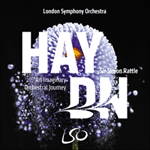Symphonies Nos 90 and 91 were composed one after the other in 1788. While all three symphonies recorded here open with a slow introduction, No 90 is unique among them in the way the ensuing Allegro takes up, more or less intact, the main melodic idea of the Adagio. The Allegro’s secondary theme is given to the flute, then the oboe, and shows Haydn’s writing for the woodwind already looking forward to the later London works. The slow movement is in one of Haydn’s favourite forms, that of double variation. A melody in F major alternates in an A–B–A–B–A pattern with a contrasting one in F minor. There follows a rather French-sounding Menuet (Haydn even uses the French title) with a delicately scored trio section. In the sonata-form finale the same idea furnishes both the first and second subject groups, the contrast being provided by texture and key. Key itself plays an important part in the remarkable ending to the movement. An extended recapitulation in C major culminates in what, to all intents and purposes, sounds like a resolute conclusion. But Haydn has a trick up his sleeve. He gives the whole orchestra four bars rest then takes up fragments of the main theme a semitone higher, in D flat major, and spends a lengthy coda bringing the music back soundly to C again.
from notes by Matthew Rye © 1991
Les symphonies 90 et 91 furent composées l’une après l’autre en 1788. Les trois symphonies enregistrées ici débutent toutes par une lente introduction, mais le no90 est unique parmi elles pour la façon dont l’Allegro suivant reprend l’idée mélodique principale de l’Adagio, plus ou moins intacte. Le thème secondaire de l’Allegro est confié à la flùte, puis à l’hautbois, et la composition de Haydn pour les instruments à vents annonce déjà les œuvres londoniennes ultérieures. Le mouvement lent est en double variation, une des formes préférées de Haydn. Une mélodie en fa majeur alterne selon la formule A–B–A–B–A avec une mélodie contrastante en fa mineur. Puis vient un menuet assez français (Haydn va jusqu’à se servir du titre français) avec un trio à la composition délicate. Dans le finale en forme de sonate, la même idée pourvoit aux groupes du premier et du second sujet, la texture et le ton fournissent le contraste. Le ton lui-même joue un rôle important dans la fin remarquable du mouvement. Une récapitulation prolongée en ut majeur culmine en ce qui semble virtuellement une conclusion déterminée. Mais Haydn avait un autre tour dans son sac. Il accorde à l’orchestre quatre mesures de repos, puis reprend des fragments du thème principal, un demi-ton plus haut, en ré bémol majeur, et passe toute la très longue coda à ramener la musique sûrement à ut.
extrait des notes rédigées par Matthew Rye © 1991
Français: Alain Midoux
Die Sinfonien Nr. 90 und 91 entstanden nacheinander im Jahre 1788. Zwar beginnen alle drei Sinfonien dieser Einspielung mit einer langsamen Introduktion, doch die Nr. 90 zeichnet sich unter den dreien dadurch aus, daß das anschließende Allegro mehr oder weniger intakt den melodischen Hauptgedanken des Adagios aufnimmt. Das Seitenthema des Allegros wird erst der Flöte, dann er Oboe zugewiesen und zeigt die Entwicklung auf, die Haydns Stimmführung der Holzbläser in den späteren Londoner Werken nehmen sollte. Der langsame Satz hat eine Form, die Haydn besonders zusagte, die der zweifachen Variation. Dabei alterniert eine Melodie in F-Dur nach dem Prinzip A–B–A–B mit einer kontrastierenden in f-Moll. Es folgt ein recht französisch anmutendes Menuett (Haydn benutzt sogar die französische Bezeichnung „Menuet“) mit einem feinfühlig gestalteten Trio. Im Finale in Sonatensatzform versorgt das gleiche Motiv sowohl die erste, als auch die zweite Themengruppe, während Struktur und Tonart den Kontrast liefern. Die Tonart spielt eine wichtige Rolle beim bemerkenswerten Ende des Satzes. Eine erweiterte Reprise in C-Dur gipfelt in einem allem Anschein nach resoluten Abschluß. Aber Haydn hat einen Trumpf in der Hand: Er läßt das gesamte Orchester vier Takte pausieren, dann nimmt er einen Halbton höher, also in Des-Dur, Fragmente des Hauptthemas auf und verwendet eine lange Coda darauf, die Musik mit sicherer Hand nach C-Dur zurückzuführen.
aus dem Begleittext von Matthew Rye © 1991
Deutsch: Anne Steeb/Bernd Müller


 Haydn: An Imaginary Orchestral Journey
Haydn: An Imaginary Orchestral Journey
